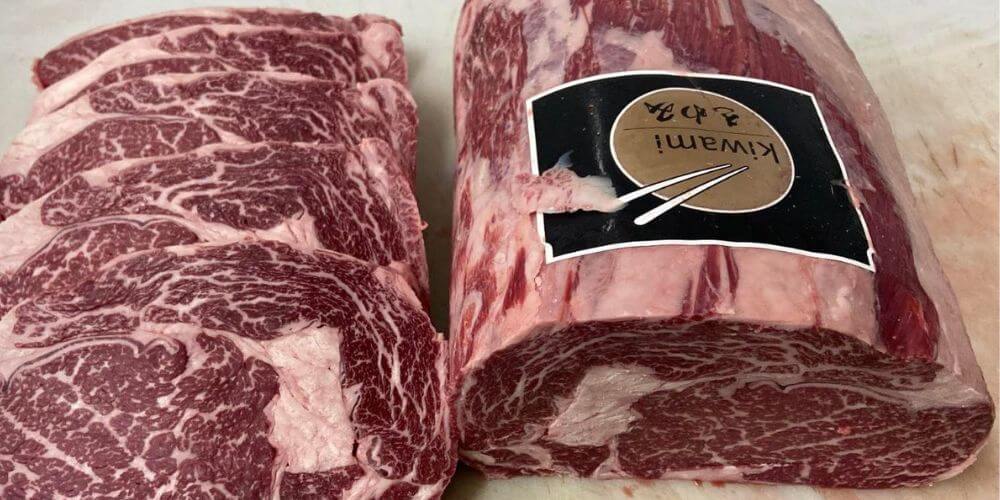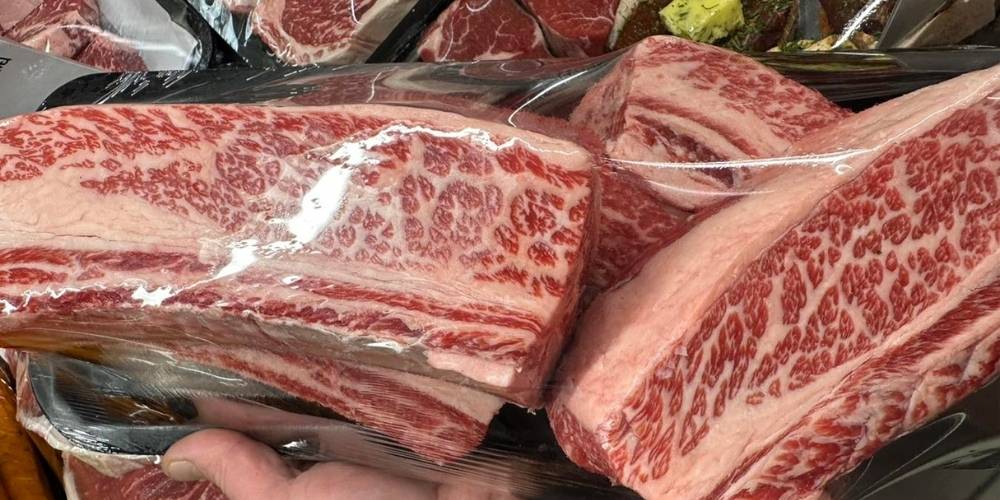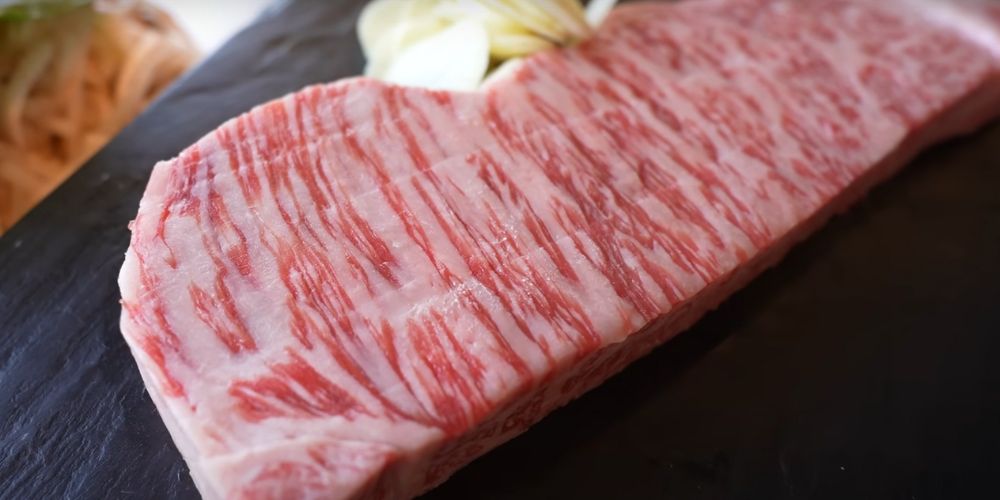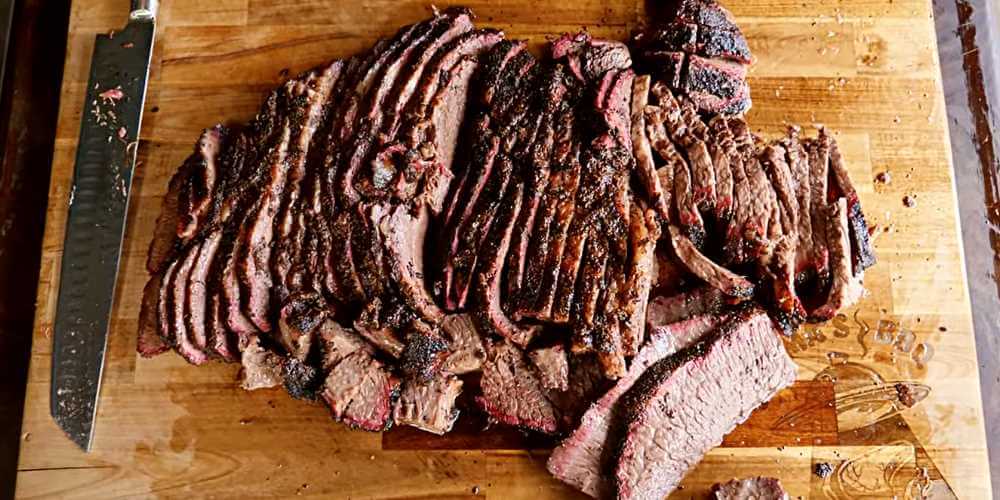
John Andrew
John Andrew, owner of The Meat Inn Place in Lilydale, boasts a legacy of butchery, offering exclusive grass-fed and free-range meats, and specialising in low-and-slow cuts. With a career inspired by his father, John’s passion and expertise have nurtured a reputable business distinguished by unique offerings like Kiwami Wagyu, driven by a commitment to quality and community service.
Why is Wagyu so expensive?
Reading Time: 8 minutes and 35 seconds

Let’s be honest—Wagyu isn’t cheap. If you’ve ever seen the price of a Wagyu steak and thought, ‘Is it really worth it?’, you’re not alone. We get that question all the time at The Meat Inn Place, and as butchers who’ve handled premium Wagyu for years, we know exactly what sets it apart. It’s not just beef with a fancy name—Wagyu is bred differently, raised on a specialised diet, and takes significantly longer to mature than standard cattle. The result? A steak with unbelievable tenderness, intense flavour, and that signature melt-in-your-mouth marbling you won’t find in your everyday supermarket beef. And because high-quality Wagyu is carefully sourced and produced in small numbers, it’s one of the most sought-after meats in the world. So, is it worth it? Stick with us—we’ll break it down and help you decide.
What Makes Wagyu So Special?
Ever had a steak so tender and juicy that it barely needed chewing? That’s Wagyu. It’s not just any beef—it comes from a select breed of cattle famous for their rich marbling and melt-in-your-mouth texture. Originally bred in Japan, Wagyu has since made its way to Australia, where farmers have perfected the art of raising top-quality Wagyu beef.
At The Meat Inn Place, we’ve worked with some of the best Japanese and Australian Wagyu cuts in Australia, and we can tell you firsthand—this is beef like no other.
Japanese Wagyu vs. Australian Wagyu
So, what’s the difference between Japanese and Australian Wagyu?
| Type of Wagyu | Key Characteristics |
| Japanese Wagyu | Raised under strict guidelines with a high-energy diet and longer feeding periods, resulting in ultra-premium marbling (A5 Wagyu). |
| Australian Wagyu | Bred from the same elite bloodlines but raised in Australia using local feeding programs, creating a balance between premium quality and accessibility. |
Both are incredibly tender and full of flavour, but if you’re after top-tier marbling, Japanese Wagyu is the way to go. If you want a more affordable premium steak, Australian Wagyu delivers an outstanding experience.
Marbling Scores & What They Mean
Japanese Wagyu is graded using a dual grading system by the Japan Meat Grading Association (JMGA) to ensure consistency, quality, and authenticity. The two main factors in grading are:
- Yield Grade (A, B, C) – Measures how much usable meat is obtained from the carcass.
- Quality Grade (1-5) – Evaluates marbling, meat colour, firmness, texture, and fat quality.
| Grading Category | Grade | Description |
| Yield Grade (Letter Grade) | A | Highest yield – 72% or more of usable meat |
| B | Standard yield – Between 69% and 72% | |
| C | Lower yield – Less than 69% | |
| Quality Grade (Numeric Score) | 5 | Excellent quality |
| 4 | Good quality | |
| 3 | Average quality | |
| 2 | Below average quality | |
| 1 | Poor quality | |
| Quality Assessment Factors | Marbling (Beef Marbling Score – BMS) | Evaluates intramuscular fat distribution |
| Meat Colour & Brightness | Determines the richness and vibrancy of the meat | |
| Firmness & Texture | Assesses how fine and consistent the meat texture is | |
| Fat Colour, Lustre & Quality | Evaluates the appearance and quality of fat |
A5 Wagyu is the most luxurious and sought-after grade, known for its exceptional marbling and melt-in-your-mouth texture.

Why is Wagyu So Expensive?
When it comes to premium beef, Wagyu is in a league of its own—but that comes at a cost. So why does Wagyu carry a higher price tag than standard beef?
At The Meat Inn Place, we know firsthand what makes Wagyu special. It’s not just about branding—it’s about selective breeding, extended rearing, strict grading systems, and unmatched marbling.
From genetic tracking to intensive feeding programs, every step of Wagyu production is designed to maximise tenderness, flavour, and quality. Let’s break down what makes Wagyu worth the investment.
Selective Breeding & Genetics
Wagyu cattle aren’t just any cows—they come from four distinct Japanese bloodlines known for their high intramuscular fat (IMF) content. Unlike conventional beef cattle, Wagyu naturally develop superior marbling, giving them their famous buttery texture and rich flavour.
| Wagyu Breed | Characteristics |
| Japanese Black (Kuroge Wagyu) | Most common breed, known for intense marbling and tenderness. |
| Japanese Brown (Akaushi Wagyu) | Leaner than Black Wagyu, but still rich in flavour. |
| Japanese Shorthorn | Less marbled but with a strong beefy taste. |
| Japanese Polled | Rarest breed, with bold umami flavours. |
Extended Rearing & Specialised Feeding
One of the biggest reasons Wagyu is expensive is time—these cattle take more than twice as long to raise as standard beef.
| Factor | Wagyu Beef | Standard Beef |
| Time on Feed | 600-700 days | 120-150 days |
| Diet | Specialised feed (barley, grain, rice straw) | Standard grain or pasture |
| Stress Management | Low-stress handling to enhance meat quality | Varies by farm |
Unmatched Marbling & Fat Content
Wagyu’s signature feature is its intramuscular fat (IMF), also known as marbling. This fine webbing of fat creates unparalleled tenderness and flavour. The higher the marbling score (MB), the more luxurious and melt-in-your-mouth the eating experience. We stock Wagyu with marbling scores from MB 2 to 10, so whether you’re after a mildly rich cut or full indulgence, we’ve got the perfect steak for you.
| Marbling Score | Fat Content | Eating Experience |
| MB 2-4 | Mild marbling | Juicier than standard beef but still balanced. |
| MB 5-7 | Medium marbling | Tender, flavourful, and well-balanced. |
| MB 8-10 | High marbling | Ultimate buttery texture and intense richness. |
Small-Scale Farming & High Labour Costs
Wagyu farming isn’t mass-produced. In Japan, Wagyu farms only raise 10-100 cattle at a time, compared to thousands in commercial beef operations.
- Farmers monitor individual cows daily, ensuring proper diet and stress-free environments.
- High labour costs add to Wagyu’s premium price—more hands-on care means better quality, but at a cost.
💡 Fact: Wagyu cattle are often raised with soothing music and gentle handling to reduce stress, which improves meat quality (Meat & Livestock Australia, 2023).
Import & Supply Chain Costs
Authentic Japanese Wagyu is strictly regulated, leading to high import costs due to taxes, quotas, and shipping fees. This makes it a luxury item with a premium price tag. However, Australian Wagyu maintains the same elite breeding standards while being more accessible. It offers exceptional marbling and quality without the high costs associated with imports. At The Meat Inn Place, we proudly source Australian Wagyu, ensuring you enjoy top-tier beef at a more affordable price.
Wagyu Certification & Grading System
Did you know that Wagyu beef undergoes rigorous grading to guarantee quality? Both Japanese and Australian Wagyu use strict scoring systems to assess marbling, tenderness, and overall excellence.
| Wagyu Grading | What It Means |
| Japanese Wagyu | Uses a dual grading system: A-C for yield (amount of usable meat) and 1-5 for quality (texture, colour, and fat marbling). The ultimate premium grade is A5, meaning top-tier meat with unparalleled richness. |
| Australian Wagyu | Rated by Marbling Score (MB) 2-10—the higher the number, the richer the marbling. MB 9+ is considered an elite Wagyu grade, comparable to high-end Japanese A5. |
A5 Japanese Wagyu and MB 9+ Australian Wagyu are considered some of the most luxurious beef options worldwide.
Is Wagyu Beef Worth the Price?
I’ll be honest—the first time I cooked a Wagyu steak, I was nervous. With a premium price tag, I didn’t want to mess it up. But the moment it hit the pan, the marbling started melting, creating the most golden, crispy crust I’d ever seen. After one bite, I understood the hype—it was unlike any steak I’d ever tasted.
If you’re wondering whether Wagyu is worth the price, let’s compare it to other premium steaks.
Wagyu vs. Other High-End Beef Cuts
- Angus Beef: Great flavour, solid marbling, but not as rich or tender.
- Grass-Fed Beef: Leaner and more robust, but lacks Wagyu’s melt-in-your-mouth texture.
- USDA Prime Beef: Good marbling, but still can’t match Wagyu’s silkiness.
If you love juicy, buttery, next-level steak, Wagyu is worth the splurge—especially for a special meal.
Does Wagyu’s Fat Make It Healthier?
Despite what you might think, Wagyu’s fat content is actually a plus. It contains higher levels of monounsaturated fats (the ‘good fats’) compared to regular beef, along with omega-3 and omega-6 fatty acids—both of which are linked to heart health (National Health and Medical Research Council, 2023).
| Fat Type | Wagyu | Regular Beef |
| Monounsaturated Fats (MUFA) | Higher | Lower |
| Omega-3 Fatty Acids | Higher | Lower |
| Saturated Fat | Lower melting point, easier to digest | Higher melting point, harder to break down |

Where to Buy Wagyu in Australia
Not all Wagyu beef is created equal, and where you buy it makes all the difference. Supermarkets sell Wagyu that’s mass-produced and often inconsistent in marbling, meaning you don’t always get the premium experience you’re paying for. At The Meat Inn Place, we source only the best Australian Wagyu, selecting cuts based on marbling, texture, and quality. Whether you’re after a perfectly seared Wagyu steak or a slow-cooked masterpiece, our selection includes grass-fed, grain-fed, and barley-fed Wagyu to suit every cooking style.
For Low & Slow BBQ lovers, we’re known for our Wagyu briskets, short ribs, and beef cheeks—cuts that are ideal for smoking, slow roasting, or braising. Unlike supermarket Wagyu, our beef is hand-picked for its balance of marbling and flavour, ensuring it cooks beautifully every time. We deliver across Melbourne, the Yarra Valley, and the Mornington Peninsula, so whether you’re after a show-stopping steak or a brisket for the smoker, we’ve got you covered. Experience the difference that butcher-quality Wagyu makes.

Cooking & Enjoying Wagyu – Tips from a Butcher
I’ve had customers tell me they’ve bought Wagyu before but never cooked it properly, and I get it—it’s not your average steak. The trick is knowing how marbling affects cooking. A Wagyu steak with a marbling score of 5 or below does well on a grill or hot pan, while higher scores (MB 6-10) are best cooked low and slow before searing. If you sous vide a heavily marbled steak, it melts just enough fat before finishing it off in a pan for the perfect crust.
The biggest mistake? Treating it like regular beef—Wagyu needs less time on the heat, no heavy seasoning, and a proper rest period. I always tell customers, “Wagyu is its own experience—enjoy it in smaller portions and let the flavour shine.” If you’re new to cooking Wagyu, start simple—salt, a hot pan, and patience will go a long way.
Why Wagyu is a Premium Experience
If you’ve made it this far, you already know that Wagyu is in a league of its own. It’s not just about the price—it’s about the meticulous breeding, the specialised diet, and the marbling that melts in your mouth. There’s a reason chefs and food lovers swear by it. Whether you’re looking for a show-stopping steak or a slow-cooked masterpiece, the right Wagyu cut can transform your meal.
At The Meat Inn Place, we know good meat makes all the difference—which is why we source only top-tier Australian Wagyu. If you’re ready to taste real butcher-quality Wagyu, we’ve got you covered. Check out our range today, and let’s get you cooking with the best beef in Australia!
Wagyu FAQ
Wagyu isn’t just known for its incredible flavour—it’s also packed with good fats. Unlike regular beef, Wagyu has higher levels of monounsaturated fats (the kind that’s better for your heart) and omega-3 and omega-6 fatty acids, which help support heart health. It also contains oleic acid, which adds to its rich flavour and contributes to its potential health benefits. So, if you’re after a steak that’s both indulgent and packed with better fats, Wagyu is a great choice.
Want to try the difference for yourself? Check out our premium Wagyu selection!
If you’ve never tried Wagyu before, you’re in for a treat. Thanks to its exceptional marbling, Wagyu has a rich, buttery flavour and a texture so tender it practically melts in your mouth. The high-fat content keeps it juicy and full of flavour, making every bite incredibly satisfying. It’s the kind of beef you don’t just eat—you experience.
Real Wagyu stands out from regular beef, but there are a few things to check before you buy. First, look for grading labels—authentic Wagyu will have a marble score (MB) or certification that verifies its quality. A trusted butcher should also be able to tell you exactly where it comes from and how it was raised. If the price seems too good to be true, it probably is—real Wagyu is a premium product, and its cost reflects the care that goes into producing it.
For guaranteed top-quality Wagyu, buy from a butcher you can trust—like us! Browse our selection today.

